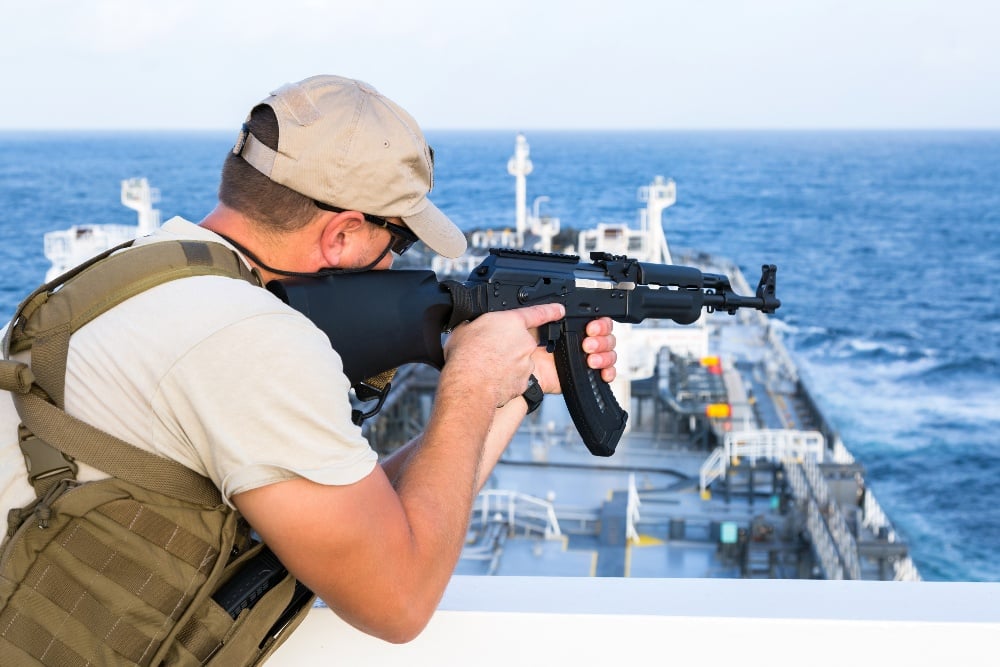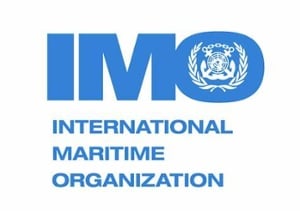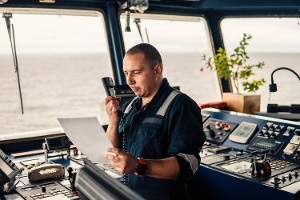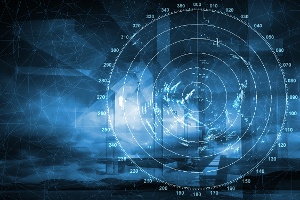
Armed and unarmed maritime security teams
Maritime security is an important requirement for merchant’s vessels. Maritime criminals and pirates continue to target ships for the value of their cargo or their crew for the subsequent ransom pay-outs.
As a result of swift international action the maritime industry witnessed a decline in piratical activity off the coast of Somalia; however, new threats are on the rise. Recent reports suggest a steady uptick of incidents of piracy in regions such as the Gulf of Guinea.
What are my options?
Maritime crime and piracy result in huge losses for shipping companies, as a result, insurers and ship operators need solutions and products to mitigate against these risks. One of the physical security options is to employ the services of privately contracted security teams:
- Private maritime security companies (PMSC): Private contractors employed to provide security personnel, both armed and unarmed, on board for protection against piracy.
- Privately contracted armed security personnel (PCASP): armed employees of PMSC.
Armed Guards and Vessel Protection Teams
Several countries across the world have introduced legislation and rules to help shipping companies place armed guards on board their vessels to safeguard the ships from acts of piracy and as a stowaway prevention measure.
The decision on the employment of Privately Contracted Armed Security Personnel (PCASP) on board ships is a complex one for a shipowner. The absence of applicable regulation and industry self-regulation coupled with complex legal requirements governing the legitimate transport, carriage and use of firearms gives cause for concern. The situation is further complicated by the rapid growth in the number of private maritime security companies (PMSC) and doubts about the capabilities and maturity of some of these companies. Significant competence and quality variations are present across the spectrum of contractors offering services.
Vessel security teams should be highly qualified, regularly vetted and experts in maritime security operations. Both armed and unarmed maritime security teams can be contracted.
A Case Study
Why the race to the bottom and low-cost does the industry no service:
"Hiring Ship Security Personnel And Armed Guards: What You Need To Know"
Vessel Protection Teams in practice – what you need to know
The size, composition and equipment of the proposed PCASP team should be carefully discussed and agreed as necessary by the shipowner contracting with the PMSC.
Factors for consideration may include:
- Size of the PCASP team – this will be influenced by factors including: length of the estimated time of the ship transit, latest threat assessment, the agreed duties of the PCASP team (e.g. will they act as additional lookouts and assist with rigging self-protection measures?) and the size and type of ship, its speed and freeboard. The analysis should indicate the minimum number of persons that should form the security team, taking into account the need for continuity of protection in the event of injury or illness;
- Ship safety certificate – the size of the PCASP team plus the crew should not exceed that specified in the ship's safety certificate. If the ship safety certificate requirements cannot be met due to added security personnel, then the flag Administration should be consulted;
- Composition – it is important that there is an appropriate hierarchy, experience and skill mix within the onboard PCASP team. The team leader should be competent in ship vulnerability and risk assessments and be able to advise on ship protection measures. It is recommended that one of the PCASP personnel be qualified as the team medic;
- Equipment requirements – this will be influenced by factors including: length of the estimated time of the ship transit, latest threat assessment, the agreed duties of the PCASP team (will they act as additional lookouts, utilize day- and night-vision equipment, assist with rigging self-protection measures?) and the size and type of ship. Enhanced medical equipment is recommended;
- Firearms – the appropriate firearms package to be employed in accordance with the applicable flag State national legislation pertaining to the type, carriage and use of firearms by PCASP, in order to provide an accurate and graduated level of deterrence, at a distance.
Maritime Safety Committee interim guidance to shipowners, ship operators and shipmasters on the use of privately contracted armed security personnel on board ships in the High Risk Area.

The purpose of this guidance is to assist shipowners, ship operators and shipmasters considering the use of PCASP on board ships to provide additional protection against piracy. It is important to note that flag State jurisdiction and thus any laws and regulations imposed by the flag State concerning the use of PMSC and PCASP apply to their ships. Furthermore, it is also important to note that port and coastal States' laws may also apply to such ships.
The use of PCASP should not be considered as an alternative to Best Management Practices (BMP) and other protective measures. Placing armed guards on board as a means to secure and protect the ship and its crew should only be considered after a risk assessment has been carried out. It is also important to involve the Master in the decision-making process.
Do you really need armed guards for your transit?
Conduct a risk assessment. Shipowners should ensure that the flag State is consulted at an early stage in their consideration of the decision to place PCASP on board to ensure that any statutory requirements are met. Whether to use PCASP within the HRA is a decision for the individual shipowner after a thorough risk assessment and after ensuring all other practical means of self-protection have been employed. The risk assessment should include and document the following factors and considerations, prior to making the determination to take such actions:
- Ship and crew security, safety and protection;
- Have all practical means of self-protection have been effectively implemented in advance?
- Potential misuse of firearms resulting in bodily injury or death;
- Potential for unforeseen accidents;
- Liability issues;
- Potential for escalation of the situation at hand;
- Compliance with international and national law.
Dryad Insight
There are many occasions when the employment of armed security teams is appropriate; there are many more occasions when it is not.
Armed security providers are not incentivised to tell you if the risk profile does not warrant their services.
We see ingrained decision habits that are hard to break; for example in the Indian Ocean the risk profile is significantly reduced from its peak and physical security teams may not be required for many operators.
Make sure all parties are fully informed.
We know how challenging it can be to convince some interested parties in - It all starts with an risk assessment that is not dependent on the sale of armed security services.
How to choose a Private Maritime Security Company (PMSC)
As with any other type of contractor, it is important to undertake the usual due diligence, which normally includes investigation and enquiries in relation to:
- Company structure and place of registration;
- Company ownership;
- Financial position (e.g. annual accounts/bank references);
- Extent of insurance cover (in particular covering third-party risks);
- Senior management experience;
- Quality management indicators – e.g. ISO certification
We conduct comprehensive due diligence checks on all the PMSC providers that we work with so that you don't have to. Learn more about our brokerage service Orion Protect
Due Diligence Guidance
Your chosen PMSC should be able to provide documentary evidence which may include:
- Maritime (as opposed to land-based) experience;
- Written procedures on management including team-leading skills, chain of authority, change in command, responsibilities in life saving;
- Understanding of flag State, port State and coastal State requirements with respect to carriage and usage of firearms;
- Availability of written testimonials/references from previous clients in the maritime industry;
- Availability of documentary evidence that firearms are procured, stored, carried, used, transported, embarked and disembarked legally;
- Understanding of the Somalia-based piracy threat including the military operations in the area, and the means to maintain current knowledge;
- Understanding of BMP and, in particular, ship protection measures;
- Access to competent maritime legal advice (e.g. in-house counsel/external legal advisers) on a 24/7 basis.

It’s not just about the quality of the PMSC, it’s also about the quality of their employees
As the quality of the service delivery depends to a very great extent on the quality and experience of the individuals that make up the onboard PCASP team, the quality of the selection and vetting of that team is essential. PMSC should demonstrate that they have verifiable, written internal policies and procedures for determining suitability of their employees.
PMSC should be able to provide documentary evidence which may include:
- criminal background checks;
- history of employment checks;
- military and law enforcement background checks, where applicable;
- records of medical, physical, and mental fitness of personnel (including regular drug and alcohol testing);
- verifiable systems in place to ensure continued suitability for employment of their personnel;
- documentary evidence of relevant experience and certification in the use and carriage of firearms to be deployed;
- systems for provision of security identity documentation, travel documents and visas.

Ensuring the PCASP team has current training is also important.
As the quality of professional training given to PCASP is of extreme importance, the shipowner should verify that the PMSC has adequate training procedures in place. The records of that training should give confidence that the PCASP have been provided with appropriate knowledge and skills.
PMSC should be able to provide documentary evidence which may include:
- comprehensive and detailed records of training, both initial and refresher training, available for inspection;
- subject to any additional requirements of the flag State, PCASP have received, as a minimum, shipboard familiarization training, including communication protocols;
- personnel have been trained and qualified to documented company standards in the appropriate use of force following recognized principles/guidelines recognized by the flag State;
- personnel have been trained to operate the specific firearms and other security equipment that will be used on the ships on which they will be deployed;
- personnel have been given medical training to a recognized international standard; personnel have been given appropriate training and/or briefing with specific reference to the ship type, where that ship will be operating, and the provisions of the International Ship and Port Facility Security (ISPS) Code, International Safety Management (ISM) Code and BMP.
Rules for the use of force
It is essential that all PCASP have a complete understanding of the rules for the use of force as agreed between shipowner, PMSC and master and fully comply with them. PCASP should be fully aware that their role in regard to the above is exclusively for the protection of life of persons on board and the ship from armed pirate attacks. PMSC should provide a detailed graduated response plan to a pirate attack as part of their teams' operational procedures.
PMSC should require their personnel to take all reasonable steps to avoid the use of force. If force is used, it should be in a manner consistent with applicable law. In no case should the use of force exceed what is strictly necessary and reasonable in the circumstances. Care should be taken to minimize damage and injury and preserve human life.
PMSC should require that their personnel not use firearms against persons except in self-defence or defence of others.

Clear Command and Control procedures are essential
A shipowner/operator when entering into a contract with a PMSC should ensure that the command and control structure linking the ship operator, the master, the ship's officers and the PCASP team leader has been clearly defined and documented. Further, prior to boarding the PCASP, the shipowner should ensure that the master and crew are briefed and exercises are planned and conducted so that all the roles and responsibilities are understood by all personnel on board prior to entering the HRA.
In order to provide the required clarity, the documented command and control structure should provide:
- Clear statement recognizing that at all times the Master remains in command and retains the overriding authority on board, and an agreed procedure in the event of the Master being unavailable;
- Clearly documented set of ship and voyage-specific governance procedures, inter alia, covering procedures for the conduct of exercises and real incidents;
- Documented list of duties, expected conduct, behaviour and documentation of PCASP actions on board;
- Transparent two-way information flow and recognizable coordination and cooperation between the shipowner, charterer, PCASP, PMSC and the ship's master, officers and crew throughout deployment.
Factors to determine such success may include: providing regular updated intelligence-based threat assessments throughout the contracted period on board, and utilizing this information to offer suggestions as to the ship's proposed routeing, amending same if required, and under the ship's contractual arrangements; .monitoring the daily activities of the onboard PCASP team; having a 24-hour emergency response and a contingency plan in place covering all foreseeable actions; and providing feedback on crew training and ship hardening requirements based upon reports received from their onboard PCASP team.

Reporting and record-keeping
The master should maintain a log of every circumstance in which firearms are discharged, whether accidental or deliberate. Such actions should be fully documented in sufficient detail in order to produce a formal written report of the incident, for the shipowner/operator to forward to the flag State.
The requirements of a formal written report may be considered to include the following:
- time and location of the incident;
- details of events leading up to the incident;
- written statements by all witnesses and those involved from the ship's crew and security team in the incident;
- the identity and details of personnel involved in the incident;
- details of the incident;
- injuries and/or material damage sustained during the incident;
- lessons learned from the incident and, where applicable, recommended procedures to prevent a recurrence of the incident.
In the event that the PCASP use force, PCASP team leaders should be advised to photograph (if appropriate), log, report and collate contemporaneous written statements from PCASP present at the incident in anticipation of legal proceedings.
PCASP reporting
In addition to incident reporting it is suggested that following a tour of duty the PCASP team should submit a full report to the shipowner/ship operator, via their employers if required, giving full details of the deployment, operational matters, any training and/or ship hardening conducted, and offering advice as to any further enhancements to security that may be considered.

Insurance and Private Maritime Security Companies
Owners should verify that PMSC maintain insurance cover for themselves, their personnel and third-party liability cover and that the PMSC terms of engagement do not prejudice or potentially prejudice the shipowner's insurance cover.
Shipowner's insurance cover Liabilities, losses and expenses arising out of the deployment of PCASP may impact on the shipowner's property and liability insurance cover. Shipowners are strongly recommended to consult with their insurers prior to contracting with and embarking PCASP to assess the potential impact on their insurance cover, particularly as it relates to armed engagements and liability insurance held by the PMSC.
PMSC insurance cover PMSC should provide evidence that they hold and will maintain for the duration of the contract:
- public and employer's liability insurance cover to an appropriate level and as required by the shipowner;
- personal accident, medical expenses, hospitalization and repatriation insurance.
- PMSC should insure their personnel to carry and use firearms on such voyages for accident, injury and damage arising from the use of firearms and liability for any claim that might arise from the carriage and/or negligent or intentional misuse of firearms.
It is vital that shipowners, charterers and underwriters review all provisions in their charters and policies and ensure adequate attention is paid to the questions raised.




